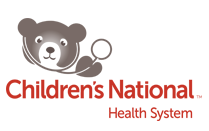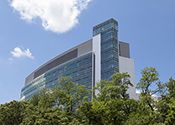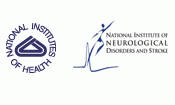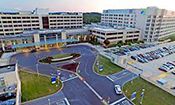
The George Washington University Hospital (GWUH)
The new George Washington University Hospital (GWUH) was opened in 2002. It is a 380 bed, 400,000 square foot tertiary care hospital. The hospital has over 875 physicians on the medical staff. The teaching staff includes both full-time and part-time voluntary faculty. There are 15,700 admissions and 127,700 outpatient visits per year. The emergency department, at this level I trauma center, sees over 61,185 patients pre year. There is a 13 room OR facility with 12,283 cases performed each year. The trauma patients and neurosurgical patients with multi-system problems are also admitted to the Medical Center's general medical-surgical ICU. This ICU is staffed by full-time intensivists under the direction of Michael Seneff, MD. In addition to the standard ICU monitoring, continuous intracranial pressure monitoring and other bedside neurophysiologic monitoring (EEG, SSEP, BAER, ) can be implemented. The in-patient Neurosurgical ward also includes a dedicated epilepsy unit where patients are evaluated with 24-hour EEG / video monitoring. The patients undergo elaborate evaluations to define surgically treatable lesions. There is a dedicated Stroke Unit.
The full time faculty group is organized as a multi-specialty group through the Medical Faculty Associates Inc. and it is the largest practice in Washington D.C. The 320 members of this group comprise 41 sub-specialties and have outpatient facilities located in the Ambulatory Care Center building located one block from the main hospital. Outpatient visits are currently scheduled four days per week with urgent visits seen as needed. The junior residents attend one day each week in the clinic to ensure an ongoing participation in the outpatient evaluation and management of Neurosurgical patients. In addition, the Chief Resident maintains weekly clinics for which he has the primary responsibility for patients for an extended period. This clinic has attending back-up and supervision.

Children's National Health System
The Children's National Health System provides comprehensive pediatric care, encompassing primary as well as subspecialty needs for the Washington, D.C. metro area and beyond through an existing network of outpatient clinics and its tertiary teaching hospital. The hospital has 279 beds, 15 PICU beds, 36 NICU beds as well as 10 operating rooms and numerous clinics and is a level 1 pediatric trauma center for Washington, D.C., Maryland and Virginia. The hospital serves a population of approximately 2,000,000 covering an area of 286 square miles. All medical disciplines are covered in addition to an ongoing development of multiple centers of excellence (Neuroscience, Cardiac and Renal, Urban Health to date).
The Department of Neurosurgery at Children's National is an integral part of the Neuroscience Center of Excellence and has three full-time staff members: the Chairman, Robert F. Keating, M.D.., and Drs. Derek Bruce, John Myseros, and Amanda Yaun. A comprehensive practice provides state-of-the-art care for tumors, vascular disease, epilepsy, hydrocephalus, trauma, spina bifida, spasticity, spinal trauma, craniofacial reconstruction, brachial plexus injuries and spine disorders.
The outpatient facilities are located within the hospital complex. The resident participates in all outpatient activities while on rotation at Children's National Hospital.

Holy Cross Hospital (HCH)
The comprehensive neuroscience program at Holy Cross Hospital, a 455 bed, not for profit teaching Hospital in Silver Spring, Maryland, serves over 36,000 patients per year and includes a team of highly skilled neurosurgeons under the leadership of Zachary Levine, MD — a nationally respected innovator of cutting-edge neurosurgical techniques.
Residents are supported by a cadre of specially trained neuroscience experts. Together they deliver critical diagnostic, medical and supportive care to help patients prepare and recover from neurosurgery treatment. Residents benefit from a depth of training and expertise that is unique for a community hospital and comparable to the quality and sophistication of any academic medical center. The team works hand-in-hand, employing the most current techniques available to accurately diagnose and treat disorders of the spine and brain that require surgical treatment including:
- Neurologic disease, such as Parkinson’s disease, essential tremor and dystonia
- Epilepsy and other seizure disorders
- Aneurysm and AVM repair
- Benign and malignant tumors of the spine and brain
- Vascular brain disorders, brain injury and structural brain conditions
- Diseases, fractures and conditions of the spine
- Stroke and other neurological emergencies

The National Institutes of Health (NIH)
The Mark O. Hartfield Clinical Research Center combined in 2004 with the Magnuson Clinical Center to create the worlds largest clinical research facility with 27 institutes. The 87,000 square foot complex has 242 in-patient beds and a 90-bed day station. The National Institute of Neurological Disorders and Stroke (NINDS) conducts and supports research on brain and nervous systems disorders. It is one of 24 institutes that comprise the N.I.H. The NINDS conducts basic and clinical research to obtain a better understanding of neurological disorders.
The Clinical service at the NIH supports an active protocol driven surgical program. The residents participate in the outpatient clinics and inpatient services under the supervision of Dr. Heiss.

Lehigh Valley Health Network
In the fifth-year residents rotate for 6 months at the Lehigh Valley Fleming Neuroscience Institute in Allentown, Pennsylvania, the flagship hospital of a 13-hospital network. This senior resident rotation pushes operative growth in preparation for the Chief Resident year. Residents work under the direction of Dr. Walter Jean, MD, and GW Neurosurgery alumnus Dr. Greg Davis.”